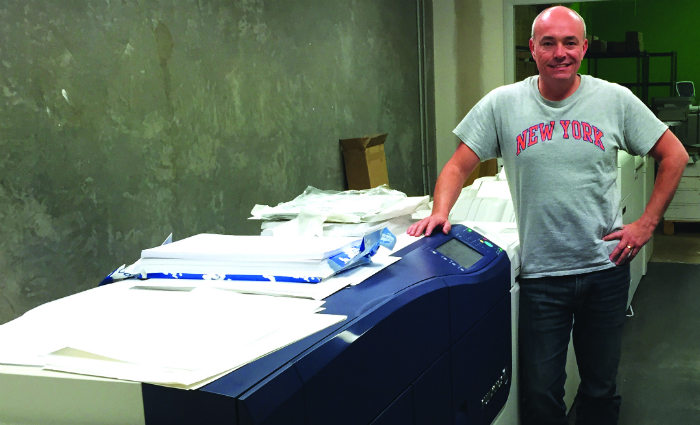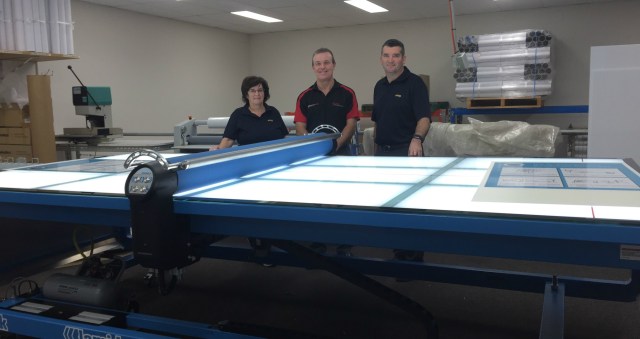
So you may remember back in November I mentioned that I bought a new press. It has taken a long time due to a major stuff up by the bank, but we’ve finally got it on the floor, and I thought a few real time notes on the install might be interesting. No PR or bull’s sheets.
We bought the Fuji Xerox Versant 2100 with the high capacity delivery and aN inline Plockmatic Pro35 finisher. That’s ten metres of press for you, which involved knocking down a wall and rearranging our entire digital press room, something the Xerox guys did happily and for free (not the wall).
Apparently this is only the second install of the inline finisher on the 2100 in the country and the other was in Adelaide. That may sound cool, like I’m so rad and ahead of all you suckers, but when every service technician whistles and points it out before picking up tools, it just makes me nervous. But so far so good.
We’re upgrading from a five year old Xerox 700 – a great machine that has clocked up six million impressions. I’d buy it again in a second, and I’m keeping it running as a backup for as long as Xerox will service it.
Our main goal in buying the new press was to reduce production steps and speed things up when producing small run magazines as we do lots of runs between 50 and 300 of various zines and books. We were printing them on the 700 and doing ganged stitching runs on our Horizon line, but the Horizon was getting very old and just wasn’t coping with the thicker books or glossier stocks. I’m hoping the Plockmatic will work well enough that I can use the space for other stuff.
The first job we ran on the 2100 was a series of art prints for a group of US and Canadian artists visiting Sydney for Supanova Expo. The quality was really quite amazing and they loved how it came out – said it was better than the stuff they could get at home.
Biggest surprise was the speed – it feels like it is almost twice the pace of the 700. I ran some 300gsm through it double sided. It was spitting them out amazingly fast and that stock was always the slowest and most challenging on the 700.
It is also much more reliable in terms of running. So far the only jams I’ve had are when perfecting 350gsm through some of the trickier finishing sections. It really doesn’t like sending that super thick stuff anywhere but the top trays – but since we haven’t traditionally done this weight in big runs before that is ok for the moment. Might be something we need to look at in the next few weeks, though.
I’m really happy with the Pro35 too. My main zines have 170gsm covers and 113gsm text – I’ve run hundreds so far with no jams or issues. It prints and cuts straight every time and gives you control over everything you’d need without overcomplicating it. I’ve seen the work that comes out of some of those square-edge trimmers Xerox were selling and most of them have had a problem with the image drifting and being trimmed off. I haven’t seen any of that so far with the Pro35.
The scoring function is really useful too – no more cracking or having to pre-score covers before they hit the Horizon.
The Plockmatic struggled when I tried to put print on a 350gsm cover through the Versant so I’m a bit doubtful on some of the claims about thick stocks. That said, I’ve run several hundred books with 300gsm matt celloed covers fed from the post-press feeder and they have come out perfect.
It also has a small issue in that while the machine can physically trim a 25mm fore edge, the installed software will only allow it to trim 16mm. Some Plockmatic departments not talking to each other there, but that will be an easy fix in the first software upgrade. In the meantime it just means being a bit more careful about pre-trimming stocks for any odd-sized books I’ll be doing.
My only complaint with the Plockmatic is the disposal of the trimmed waste. They have a belt running the offcuts to the back of the machine, which is frustrating considering every other control is on the front. It doesn’t take long for the waste build up and stop the machine so you have to run around the back to clear the pile and it’s a big machine. I can see some kind of automatic waste disposal system in my future.
I’m yet to see if the toner will celloglaze – I was never happy with the celloglazing on the 700 and in fact I refused to do it as it was likely to peel. I’ve done one test book and have it sitting on my desk waiting to see how it will go.
The only real downside is that we are having problems with the Fiery rip. I’ve been happily using Xerox’s FreeFlow on the 700 and my black and whites and it’s simple, stable and functional. The Fiery has some great functions that FreeFlow doesn’t, but in general I am finding it more difficult and fairly buggy. For example, if I drop a book file into Command Workstation as a PDF I can set up a 200gsm cover and 100gsm text, but if I print it from my desktop to the machine, it faults out the second you try to use Mixed Media.
As always, the Xerox delivery and service guys were and are fantastic. Xerox sales are persistent, professional and responsive, but it is the service team who keep me buying Xerox gear.
So far then it’s pretty good – the press is fantastic and is going to make a huge difference to how we work, and I am really sold on the Plockmatic.
Stay tuned.
Baden Kirgan is managing director of Jeffries Printing Services
Comment below to have your say on this story.
If you have a news story or tip-off, get in touch at editorial@sprinter.com.au.
Sign up to the Sprinter newsletter

